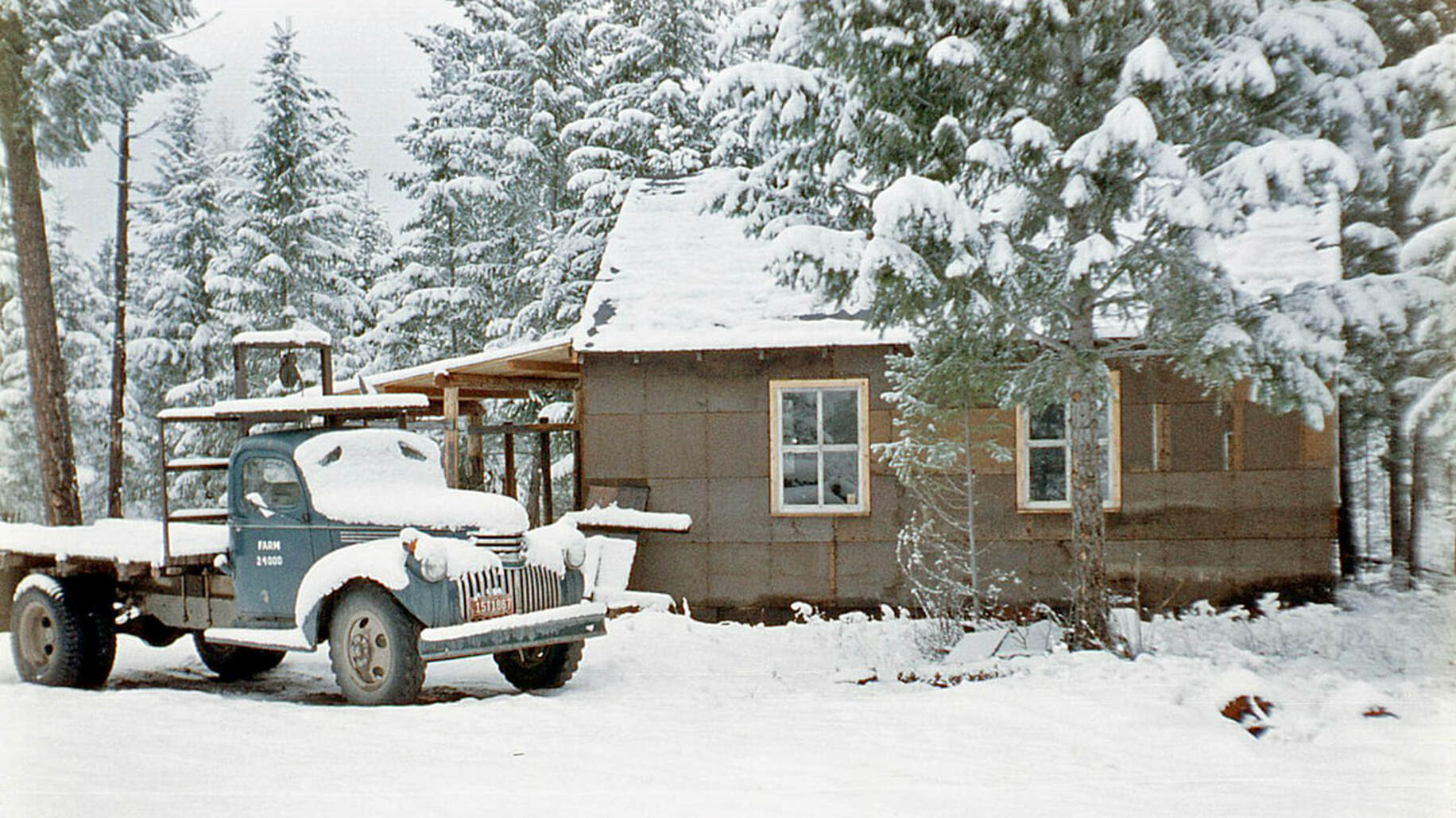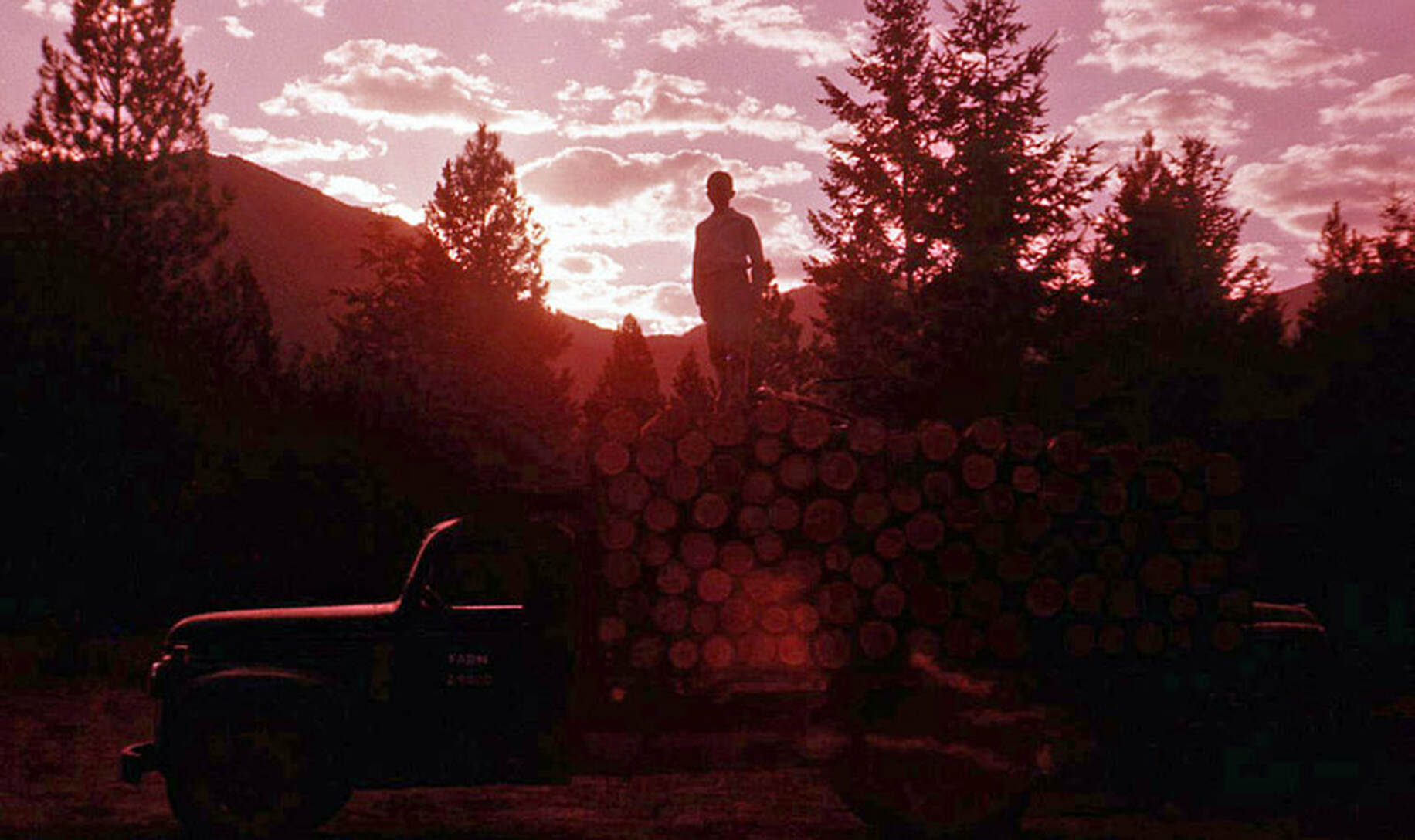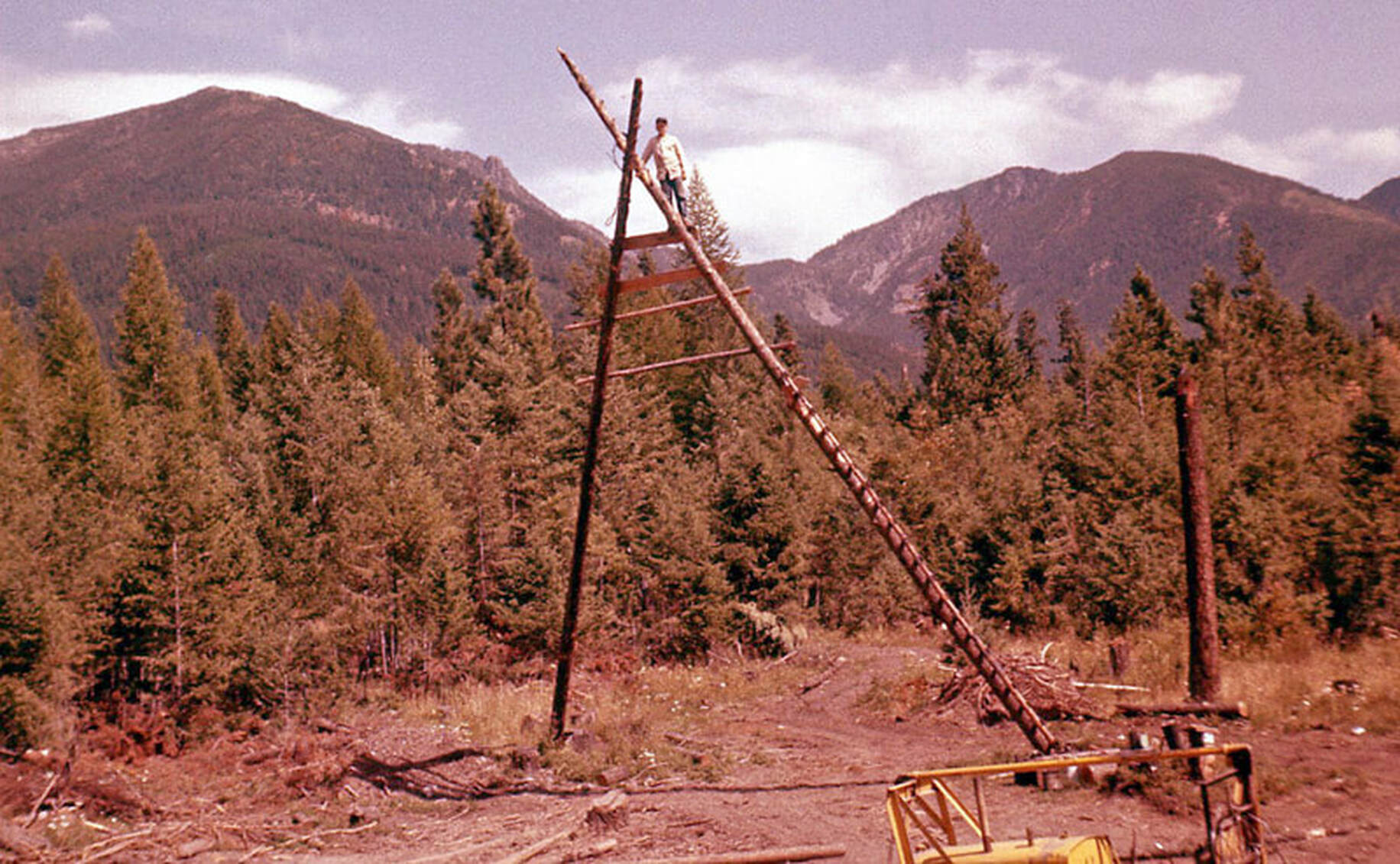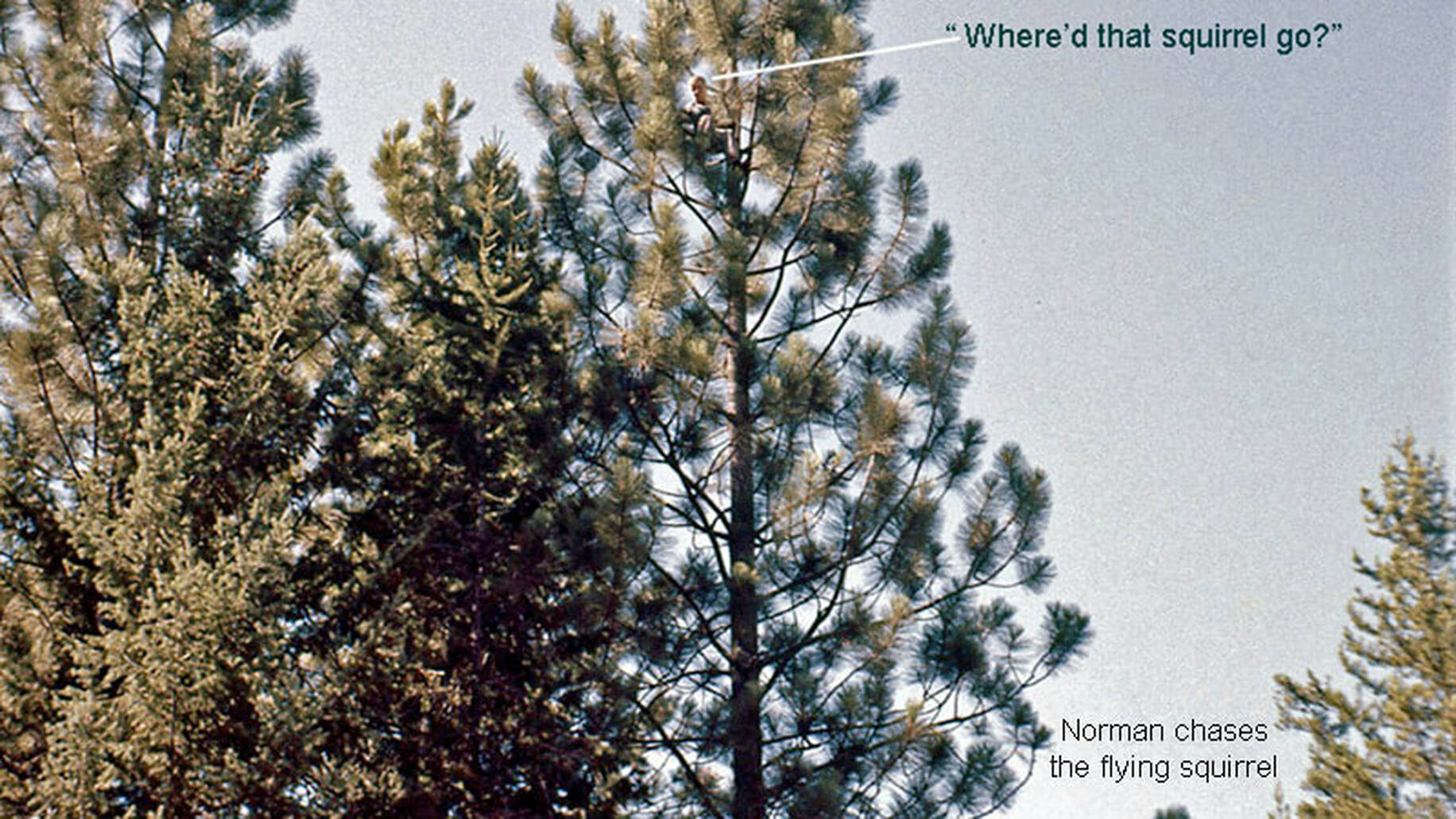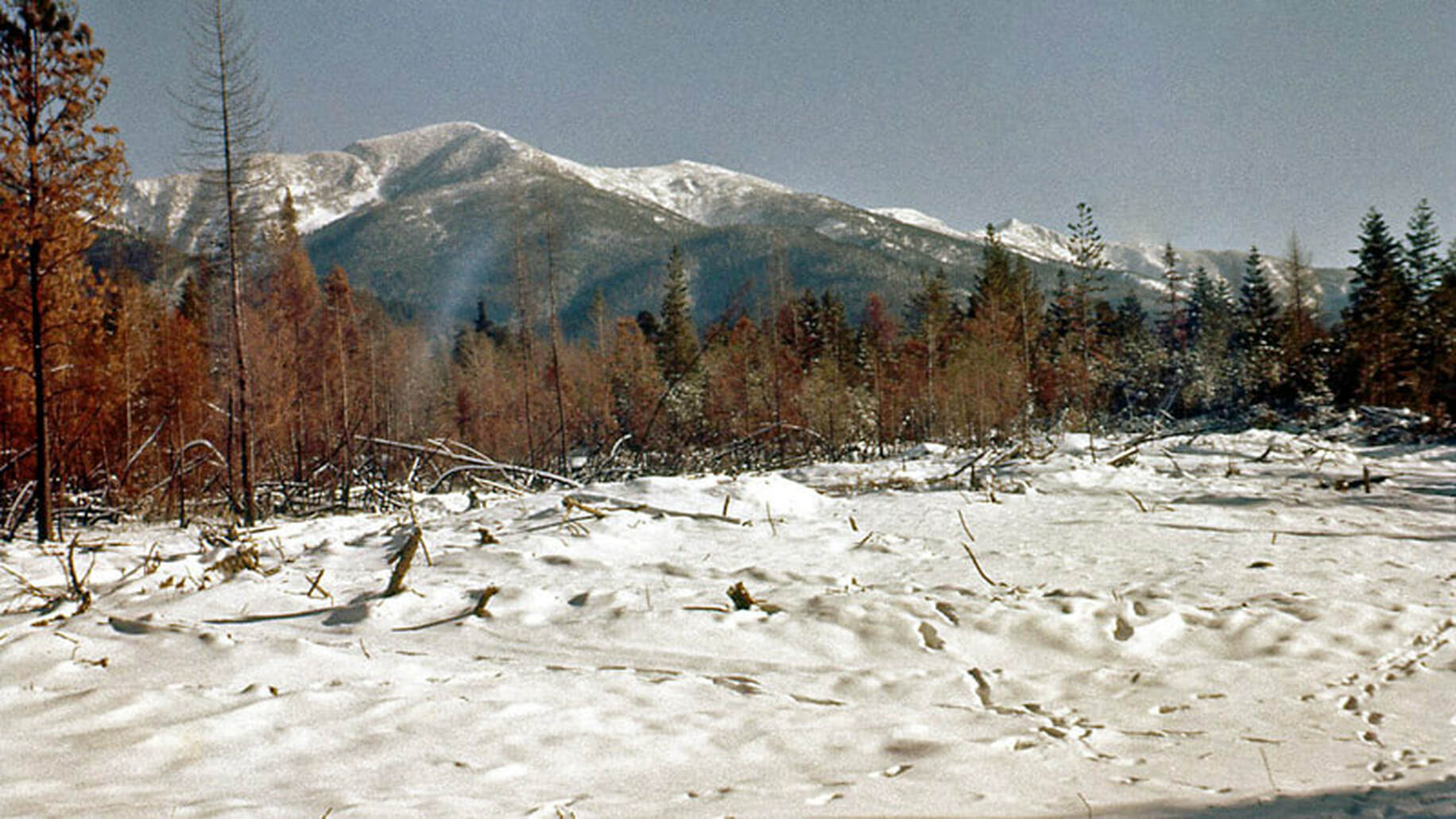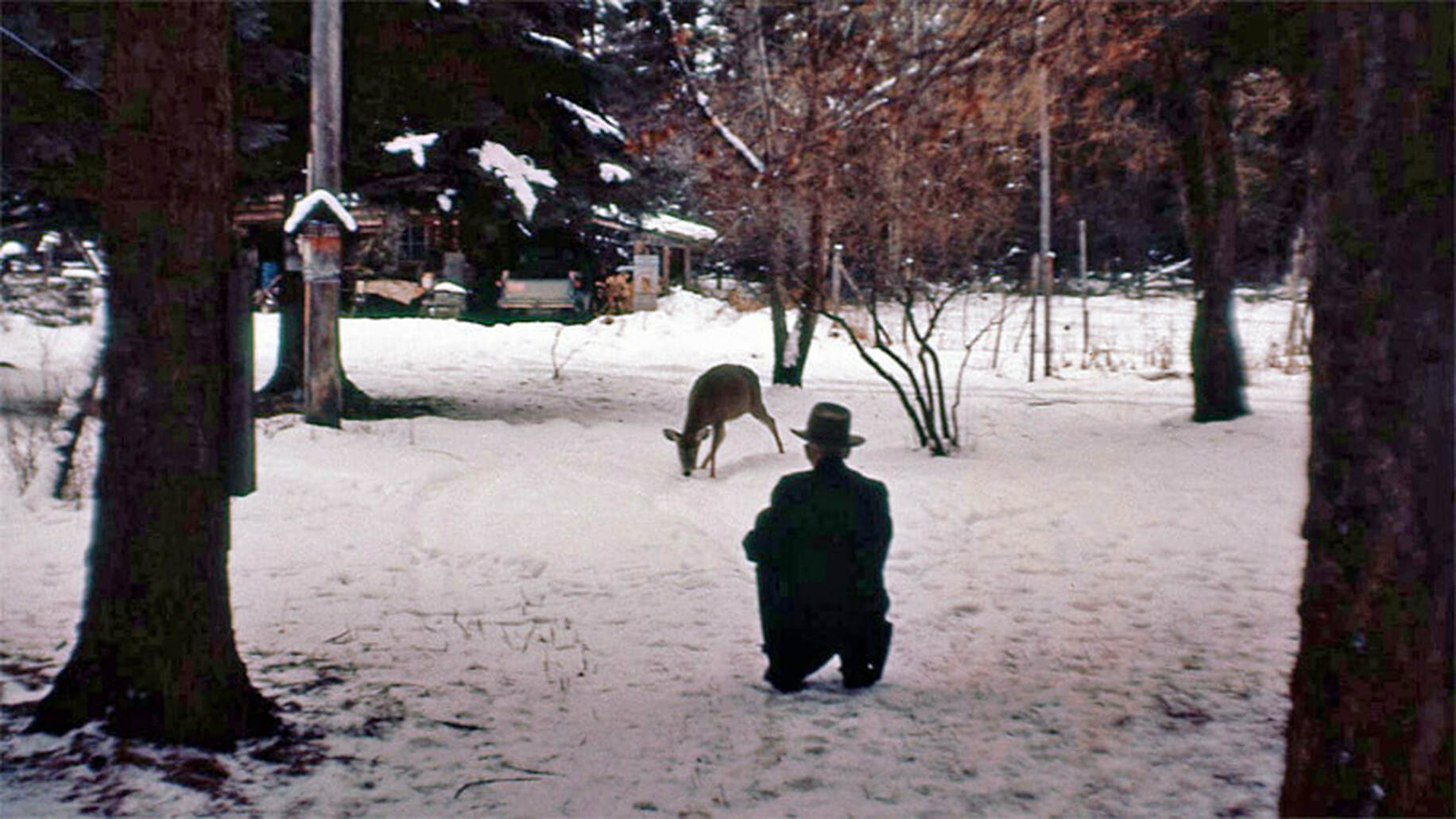New Cabin, a Tractor, Bigger Logs, and All’s Well - 1955
Bigfork Dam, from truck cab - 1955
In the spring of 1955, Dad sold the two lots at the north end of the San Rafael property.
He dismantled the 1945 shop / chicken house building, loaded it on the truck, hauled it to Bigfork,
and reassembled it at the tree farm as the ‘new’ cabin.
He dismantled the 1945 shop / chicken house building, loaded it on the truck, hauled it to Bigfork,
and reassembled it at the tree farm as the ‘new’ cabin.
The original San Rafael shop building, reassembled as A Cabin the Woods in Montana - Winter 1955
|
It’s a long way to Bigfork.
David was stationed at Ft. Huachuca, Arizona during 1955 He received a 30-day furlough in July. He hitchhiked from Arizona to Kalispell, Montana. Uncle Ernie drove him from Kalispell out to the cabin on Dad's tree farm where he stayed for several days. Cousin Carolyn came along for the ride. While at the cabin he installed
a crystal set (radio) with an aerial wire from a pole at the front roof of the cabin over to the roof of the truck garage, and a ground wire pipe outside the west window. The garage was the roof of the original 1939 cabin, mounted high on 2 rows of poles. (That pipe was still tight in the ground in 2010, the only remaining piece of the cabin.) |
The new cabin, late in its first season. It was reassembled 4' shorter than the original shop.
The original 1939 cabin was removed on completion of the second cabin.
Its round roof was used as a truck garage across from the new cabin, supported by two rows of poles, and open on all sides.
Its hand-sawed slab siding was cut for firewood.
Dad bought a Caterpillar Model 20 at Halton Tractor, and trucked it to the tree farm - Summer 1955
A load of 8' logs for the sawmill at sunrise
Norman and his bicycle took the train to Kalispell for the annual visit.
Dad met Norman at the Goss grandparent’s house; they returned to the train station to retrieve the bicycle.
Norman and the bicycle stayed at the cabin.
Dad met Norman at the Goss grandparent’s house; they returned to the train station to retrieve the bicycle.
Norman and the bicycle stayed at the cabin.
The Well
Soon after building the second cabin, Dad dug a Well nearby. A “windlass” crank was above, neatly cut round by hand.
A five-gallon pail was lowered and raised to haul out the material. As the well got deeper, a ladder was used for access.
Climbing farther up and down the ladder was wasting too much time.
One day he brought out Earl to work the topside, cranking up the 80 pound pail, while Dad remained at the bottom.
(I was 11, and too light to do this at all, let alone safely.)
The Well reached about 15’ deep through unsupported layers of Rocky Mountain rocks
and just wide enough for digging with a small shovel.
Earl cranked several thousand pounds of gravel up out of that hole that day.
He would steadily wind the bucket to the top, hold the crank handle in place with one arm, carefully reach out with the other,
pull the bucket back toward him, and then dump it out onto the growing pile of gravel.
The gravel pile got so large that Dad later used it to load the tractor onto the truck;
backing the truck up to one side of the pile, then driving the tractor up the other side.
This bucket lifting had to be done with absolute safety since Dad would have had no place to hide if the bucket dropped.
I had heard only negative things about Earl (from his closest Goss relative).
After seeing him do that heavy, dangerous work all day, flawlessly, my respect for him increased greatly. – n
Soon after building the second cabin, Dad dug a Well nearby. A “windlass” crank was above, neatly cut round by hand.
A five-gallon pail was lowered and raised to haul out the material. As the well got deeper, a ladder was used for access.
Climbing farther up and down the ladder was wasting too much time.
One day he brought out Earl to work the topside, cranking up the 80 pound pail, while Dad remained at the bottom.
(I was 11, and too light to do this at all, let alone safely.)
The Well reached about 15’ deep through unsupported layers of Rocky Mountain rocks
and just wide enough for digging with a small shovel.
Earl cranked several thousand pounds of gravel up out of that hole that day.
He would steadily wind the bucket to the top, hold the crank handle in place with one arm, carefully reach out with the other,
pull the bucket back toward him, and then dump it out onto the growing pile of gravel.
The gravel pile got so large that Dad later used it to load the tractor onto the truck;
backing the truck up to one side of the pile, then driving the tractor up the other side.
This bucket lifting had to be done with absolute safety since Dad would have had no place to hide if the bucket dropped.
I had heard only negative things about Earl (from his closest Goss relative).
After seeing him do that heavy, dangerous work all day, flawlessly, my respect for him increased greatly. – n
Earl at Kalispell – Christmas 1955
The Well digging struck only ‘moisture.’
It would have required only a few more feet to produce a well, but it was already dangerously deep.
Dad had worked in the Hecla Mine for six years and was ‘well’ aware of cave-ins and the importance of preventing them.
The Well project was abandoned.
It would have required only a few more feet to produce a well, but it was already dangerously deep.
Dad had worked in the Hecla Mine for six years and was ‘well’ aware of cave-ins and the importance of preventing them.
The Well project was abandoned.
Hog Warts
Norman had a wart on a finger of one hand.
His mother drew from ‘Homestead Healthcare’ (“We don’t need no dum doctors”)
and prescribed repeatedly applying a razor blade to the wart until it was completely removed.
This ‘surgery’ would cause temporary bleeding.
Norman continued this razoring regularly for a few weeks. The wart remained and another one appeared nearby.
The razor blade remedy was redoubled.
Another wart appeared. And another. And another. “Keep cutting, it’ll work.”
A wart appeared on the back of the other hand. Norman was wearing out a lot of razor blades.
“Keep cutting.”
More warts appeared on the second hand. This razor regimen was a required routine for many months.
There were about a dozen warts across two hands.
During the 1955 tree farm visit, Dad took Norman to the doctor in Kalispell,
the same one who had treated Dad’s accident the year before.
The doctor applied a ‘super-cold’ instrument head for a few seconds to each wart, freezing the virus.
It felt hot. Apparently, nerve sensor interpretations do not recognize super-cold,
and ‘assume’ that this temperature extreme must be heat.
Many days later, the warts were diminishing in size. Several weeks later, they were completely gone.
Norman’s mother continued to insist that the razor blade project had been the ‘cure’ for the warts,
and that the doctor’s treatment was a waste of time and money.
It’s obvious now, of course, that the repeated cutting and bleeding was spreading the virus,
which was oblivious and impervious to the all the soap and water.
Norman had a wart on a finger of one hand.
His mother drew from ‘Homestead Healthcare’ (“We don’t need no dum doctors”)
and prescribed repeatedly applying a razor blade to the wart until it was completely removed.
This ‘surgery’ would cause temporary bleeding.
Norman continued this razoring regularly for a few weeks. The wart remained and another one appeared nearby.
The razor blade remedy was redoubled.
Another wart appeared. And another. And another. “Keep cutting, it’ll work.”
A wart appeared on the back of the other hand. Norman was wearing out a lot of razor blades.
“Keep cutting.”
More warts appeared on the second hand. This razor regimen was a required routine for many months.
There were about a dozen warts across two hands.
During the 1955 tree farm visit, Dad took Norman to the doctor in Kalispell,
the same one who had treated Dad’s accident the year before.
The doctor applied a ‘super-cold’ instrument head for a few seconds to each wart, freezing the virus.
It felt hot. Apparently, nerve sensor interpretations do not recognize super-cold,
and ‘assume’ that this temperature extreme must be heat.
Many days later, the warts were diminishing in size. Several weeks later, they were completely gone.
Norman’s mother continued to insist that the razor blade project had been the ‘cure’ for the warts,
and that the doctor’s treatment was a waste of time and money.
It’s obvious now, of course, that the repeated cutting and bleeding was spreading the virus,
which was oblivious and impervious to the all the soap and water.
Bigger Logs
Dad built a tall ‘A-frame’ structure to load 16’ logs.
Dad built a tall ‘A-frame’ structure to load 16’ logs.
It was located on the site of the previous year’s accident. Swan Range in background - Summer 1955
This had become the new staging area.
I believe the frame used the same two trees which had been the ‘catapult’ of the previous year’s accident.
The poles were anchored on the ground against their own stumps, and then suspended vertically by a cable
tied back to the base of a stout tree off the edge of the clearing.
It stood for 3 years, then lowered in 1958 when the logging chapter was closed.
I believe the frame used the same two trees which had been the ‘catapult’ of the previous year’s accident.
The poles were anchored on the ground against their own stumps, and then suspended vertically by a cable
tied back to the base of a stout tree off the edge of the clearing.
It stood for 3 years, then lowered in 1958 when the logging chapter was closed.
Norman climbs to the top of the frame to haul up the sheave block, and then thread the cable
Loading longer logs
Clean shirt, and another load of logs heads for the sawmill
Another flying squirrel climbs up to the launch pad
Christmas Trees
Dad remained through the end of the season, cutting many Christmas trees.
Tractor hauls out a sled load of trees. Earl’s car next to truck - Fall 1955
Hauling out another load on a nice fall day in the woods
It's beginning to look a lot like snow
Frosting on the Swan
Piling up a bed of snow
Forest Fire
Burn site
Several acres near the border of the tree farm burned, cause unknown. It did not occur where Dad had been working.
An adjacent property owner suggested that Dad's logging activity may have caused it.
As a preemptive legal defense, the property was transferred to the children until the matter was closed.
"For a price of $1.00 and love and affection."
An adjacent property owner suggested that Dad's logging activity may have caused it.
As a preemptive legal defense, the property was transferred to the children until the matter was closed.
"For a price of $1.00 and love and affection."
Scorched trees
Don’t Feed the Deer!
Tempting a deer at the Halverson Herd
This cautious deer would never survive at Wallowa Lake
Vicious furry dog on guard against boredom. Dad feeds the deer at Halverson’s. - December 1955
Season's Over
Cabin boarded, tractor and tools are loaded, last tree of the year is on top, headed for a San Rafael Christmas. - 1955
Leaving freezing Flathead Lake; escaping the Ice Age. Highway 28, above Big Arm.
Home just in time for the Silver Thaw - December 1955
A Montana tree grows at San Rafael Street - 1955
(Still have the basketball; hoop remained attached to back of garage until 1970)
(Still have the basketball; hoop remained attached to back of garage until 1970)



